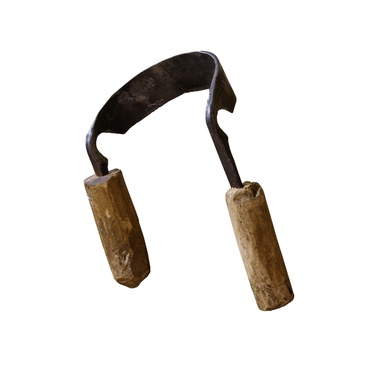The shutters were made by an unknown craftsman from the Sorliney village, Ardatovsky Uyezd, Simbirsk Province. The participants of the ethnographic expedition in 1969, from the Mordovian Research Institute of Language, Literature, History, and Ethnography donated the shutters to the museum.
The shutter front side is decorated with an ornament made in the bas-relief carving technique. The board’s lower edges are framed with cover fillets about 4 centimeters wide. The craftsman arranged the carved composition symmetrically to the board’s vertical axis. The solar sign (with multi-petal rosette inscribed in a circle and eight-pointed palmette) is in the lower third part. The two curved branches with offshoots elevated from the sign and having closed up make an openwork composition of symmetrical curls. The craftsman varied the relief elements with the traditional Mordovian chip carving technique: for example, one can see unguiform cuts on the branches.
The wooden window shutters appeared long before the widespread use of window glass. They protected against the cold, wind, rain, and sunlight. The shutters were closed at night securing the house from thieves.
The windows were often decorated with carved shutters. The carved décor on window trims, friezes, and frontals of Erzya dwellings was made across Alatyr and Ardatov Uyezds, and Simbirsk Province territories. Bas-relief carving, also called “ship” carving, was a national Mordovian technique. It was common in the Trans-Volga region of Nizhny Novgorod and developed thanks to the carvers who worked on the shipbuilding of the Volga region.
Russian carpenters played an important role in the ship bas-relief carving technique formation. This kind of technique emerged in the early 19th century in the Russian districts of Nizhny Novgorod Province. In the 1840s — 1880s, the bas-relief carving became popular Pri-Alatyr and Pri-Sur districts of the Mordovian region. It was established because the craftsmen inscribed the date of the work.
Floral motifs prevailed in the patterns. The carvers paid much attention to window surrounds and did their utmost to demonstrate their own skills when decorating double-panel shutters. The bas-relief carving was the most convenient technique, as even richly decorated shutters did not lose their practical meaning. The motifs of blind carving were of the same type, which indicates the use of stencils in this technique.
The shutter front side is decorated with an ornament made in the bas-relief carving technique. The board’s lower edges are framed with cover fillets about 4 centimeters wide. The craftsman arranged the carved composition symmetrically to the board’s vertical axis. The solar sign (with multi-petal rosette inscribed in a circle and eight-pointed palmette) is in the lower third part. The two curved branches with offshoots elevated from the sign and having closed up make an openwork composition of symmetrical curls. The craftsman varied the relief elements with the traditional Mordovian chip carving technique: for example, one can see unguiform cuts on the branches.
The wooden window shutters appeared long before the widespread use of window glass. They protected against the cold, wind, rain, and sunlight. The shutters were closed at night securing the house from thieves.
The windows were often decorated with carved shutters. The carved décor on window trims, friezes, and frontals of Erzya dwellings was made across Alatyr and Ardatov Uyezds, and Simbirsk Province territories. Bas-relief carving, also called “ship” carving, was a national Mordovian technique. It was common in the Trans-Volga region of Nizhny Novgorod and developed thanks to the carvers who worked on the shipbuilding of the Volga region.
Russian carpenters played an important role in the ship bas-relief carving technique formation. This kind of technique emerged in the early 19th century in the Russian districts of Nizhny Novgorod Province. In the 1840s — 1880s, the bas-relief carving became popular Pri-Alatyr and Pri-Sur districts of the Mordovian region. It was established because the craftsmen inscribed the date of the work.
Floral motifs prevailed in the patterns. The carvers paid much attention to window surrounds and did their utmost to demonstrate their own skills when decorating double-panel shutters. The bas-relief carving was the most convenient technique, as even richly decorated shutters did not lose their practical meaning. The motifs of blind carving were of the same type, which indicates the use of stencils in this technique.



